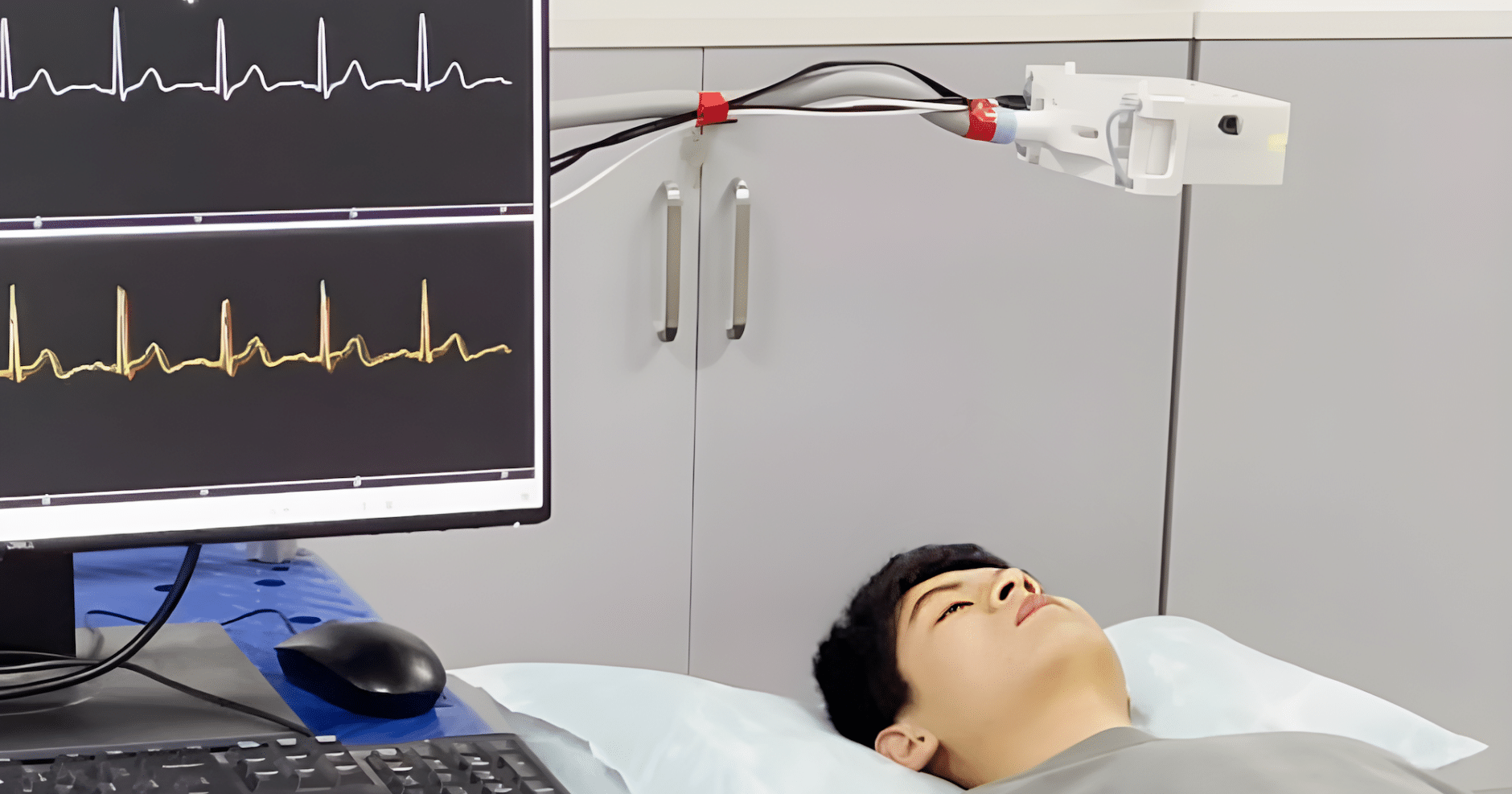- What Is Contactless Monitoring?
- Architecture, Processes, And Types Of ECG Monitoring Systems
- The Technology Behind Contactless ECG Monitoring Systems
- Applications In Diagnosing And Monitoring Heart Health
- Advantages Of ECG Contactless Monitoring Systems
- Limitations And Challenges
- The Future Of Heart Health Monitoring With Contactless ECG Monitoring Systems
- Enroll In An ECG Interpretation Course Today
The introduction of contactless ECG monitoring systems marks the beginning of a new era in heart health monitoring.
This state-of-the-art technology provides a noninvasive, accurate, and continuous method of monitoring cardiovascular well-being with far-reaching implications for early diagnosis and treatment planning.
Keep reading to learn more about the latest developments in non-contact ECG monitoring systems and their potential to revolutionize how healthcare professionals manage heart health.
What Is Contactless Monitoring?
Conventional electrocardiogram monitoring uses electrodes taped directly to the patient’s skin, usually on the upper body, to measure the heart’s electrical activity over time.
Contactless ECG technology uses millimeter-wave radar and artificial intelligence to infer an ECG signal without ever making direct contact with a patient. This technology offers many opportunities for improved patient care, streamlined workflows, and enhanced clinical outcomes.
Through the use of cutting-edge technology and innovative design, these systems provide a more accessible, convenient, and efficient approach to cardiac monitoring.
The Limitations Of Traditional ECG Monitoring
While conventional ECG monitoring has changed the healthcare system for the better, this method has significant limitations. For one, attaching the electrodes to the patient’s body can be time-consuming and can yield inaccurate results if leads are not placed correctly. This can hinder the timely diagnosis and treatment of severe cardiovascular disease — a significant issue given the prevalence of these conditions worldwide.
Traditional ECGs also limit a patient’s mobility by requiring a cable connection between them and the recording device during data collection. Patients monitored long-term at home may experience mobility restrictions during daily activities or sleep disturbances if required to wear the sensors overnight.
Architecture, Processes, And Types Of ECG Monitoring Systems
ECG monitoring systems have evolved significantly over the years thanks to technological advances and the growing need for efficient and accurate cardiovascular disease (CVD) diagnosis. The design of these ECG monitoring systems varies depending on factors like the type of device (wearable or stationary), connectivity infrastructure, data processing capabilities, and user interfaces.
Today, several types of ECG monitoring systems exist, from traditional 12-lead electrocardiograms to portable single-lead devices to wearable monitoring systems.
Contactless ECG monitoring is the latest in ECG monitoring tech. It is not only convenient and easy to use but also provides accurate and reliable data that can be used to detect potential cardiac abnormalities.
This system works by utilizing a non-invasive medical sensor to detect the electrical signals generated by the heart, which are then analyzed by sophisticated algorithms to create a digital representation of the user’s heart rate over time.
The data collected by the sensor is then sent to the user’s smartphone or computer, allowing them to track their heart rate in real time. It can also be shared with healthcare providers so they can more closely monitor the user’s health and provide tailored advice.
Review Of Literature On ECG Contactless Monitoring Systems
Pioneering research by Marzbanrad et al. (2018) presented a novel method using millimeter wave technology to cross the boundary between mechanical and electrical cardiac activity and provide reliable and accurate ECG readings without direct contact.
Subsequent studies have explored various applications of this promising technology, from improved diagnostics to remote patient monitoring, demonstrating its versatility in addressing multiple challenges in cardiovascular healthcare.
For example, Scalise & Morbiducci (2020) investigated how these noninvasive devices can detect heartbeats by combining radar sensors with machine learning.
In addition, several investigators have demonstrated the feasibility of integrating noncontact ECG monitoring systems into wearable devices to expand accessibility and provide real-time feedback on patients’ current cardiac health.
The Technology Behind Contactless ECG Monitoring Systems
Contactless ECG monitoring systems involve a combination of capacitive or electromagnetic sensing, advanced signal processing, artificial intelligence (AI), and machine learning (ML) algorithms. These technologies work together to provide accurate, non-invasive cardiac monitoring that can revolutionize heart health management and improve patient outcomes.
Capacitive And Electromagnetic Sensing
Capacitive sensing is one of the primary technologies used in contactless ECG monitoring systems. Capacitive sensors can remotely detect and record the heart’s electrical activity by measuring changes in electric fields.
On the other hand, some contactless ECG monitoring systems use electromagnetic sensing technology to capture cardiac activity. These systems use magnetic field sensors, such as magnetometers, to detect and measure the magnetic fields generated by the heart’s electrical activity.
Both of these sensors are highly sensitive and can detect even the smallest variations in electric fields, allowing for accurate and consistent ECG data collection without direct contact with the patient’s skin.
Raw data collected by capacitive or electromagnetic sensors can be affected by various noise sources, such as interference from electrical equipment or muscle movement. To eliminate this noise, advanced signal processing and filtering techniques are used to ensure that the resulting ECG data is accurate and reliable. These techniques include digital filtering, adaptive noise cancellation, and artifact removal algorithms.
Artificial Intelligence (AI) And Machine Learning (ML) For Accurate Analysis
Artificial intelligence (AI) and machine learning (ML) are changing how we diagnose and treat medical conditions, especially cardiology. Contactless ECG monitoring systems utilize AI and ML to analyze ECG signals and make diagnoses faster and more accurately.
ML workflows can also help monitor vital signs such as heart rate, respiratory rate, cough rate, blood pressure, and other parameters that remotely determine a patient’s health status. This technology enables real-time, non-invasive monitoring of patients with heart disease or sleep apnea, allowing timely intervention at home if needed.
By identifying patterns and anomalies in the data, these algorithms can assist healthcare professionals in diagnosing and monitoring various cardiac conditions.
Applications In Diagnosing And Monitoring Heart Health
ECG contactless monitoring systems enable healthcare professionals to develop personalized treatment plans and improve patient outcomes across a wide range of health conditions, including diagnosing and monitoring heart disease, sleep apnea, and stress management.
Monitoring For Arrhythmias
Contactless ECG monitoring systems play a critical role in the early detection and management of arrhythmias. These systems provide a more comfortable and non-invasive method of detecting irregular heartbeats by continuously monitoring a patient’s cardiac activity without direct skin contact.
Early detection of arrhythmias, such as atrial fibrillation, ventricular tachycardia, or bradycardia, can help healthcare professionals develop appropriate treatment plans and reduce the risk of complications such as stroke or heart failure.
Diagnosing Sleep Apnea
Contactless monitoring systems can analyze fluctuations in heart rate patterns during sleep, providing valuable insights into the patient’s sleep quality and overall health. By detecting irregularities in heart rate and identifying apnea episodes, healthcare professionals can diagnose sleep apnea and develop personalized treatment plans.
Early diagnosis and intervention can significantly improve sleep quality, reduce daytime fatigue, and lower the risk of sleep apnea-related complications such as hypertension, heart disease, and stroke.
Detecting Stress Patterns
Stress-induced changes in heart rate variability, a measure of the variation in time between successive heartbeats, can be identified using these advanced monitoring systems. By analyzing this data, healthcare professionals can gain insights into a patient’s stress levels and emotional well-being.
This information can be used to develop personalized stress management and mental health treatment plans, ultimately improving the patient’s overall quality of life.
Advantages Of ECG Contactless Monitoring Systems
Contactless ECG monitoring systems offer benefits to both patients and healthcare professionals. By harnessing the potential of these innovative technologies, medical professionals can further improve patient care, optimize resource allocation, and revolutionize heart health management.
Remote Continuous Monitoring And Early Detection
These innovative systems provide continuous, real-time monitoring of a patient’s cardiac activity, allowing healthcare professionals to identify early signs of heart abnormalities. This constant data stream enables timely interventions, ultimately improving patient outcomes and overall heart health management.
As a bonus, patients can be monitored at home, work, or on the road without disrupting their daily routines.
Remote contactless ECG monitoring systems may result in fewer hospital readmissions and more efficient resource allocation. They can also be particularly beneficial for patients in rural or underserved areas with limited access to specialized cardiac care.
Non-Invasive And Increased Accuracy Of Diagnoses
Contactless ECG monitoring systems offer a non-invasive way to collect data and accurately diagnose heart disease. Traditional ECG devices involve placing electrodes on the patient’s chest, arms, and legs, which can be uncomfortable, time-consuming, and result in inaccurate readings if proper positioning is not maintained. Not to mention, these electrodes can cause skin irritation or infection.
Contactless monitoring eliminates this risk and provides a safer and more hygienic monitoring solution for patients, especially those with sensitive skin or allergies.
By reducing errors caused by improper electrode placement or limb positioning during traditional ECG exams, physicians can rely more heavily on contactless ECG diagnosis to make better treatment decisions.
Limitations And Challenges
Despite its advantages, contactless ECG monitoring systems are still in the early stages and face limitations and challenges, including technical limitations and privacy concerns.
Data Privacy And Security Concerns
Contactless ECG monitoring systems, like all digital health technologies, need to prioritize data privacy and security to maintain patient trust and comply with privacy regulations. Secure transmission, storage, and access to patient data by authorized healthcare professionals are essential to addressing these concerns.
Using robust encryption technologies in data transmission and implementing secure storage solutions, either on-site or in the cloud, with strong encryption protocols can contribute significantly to data protection.
Technical Limitations Of ECG Contactless Monitoring Systems
Contactless ECG monitoring systems also have some technical limitations that health professionals need to be aware of, including:
- Contactless ECG monitoring systems may have reduced accuracy during high-intensity physical activity with heart rates above 100 beats per minute due to motion artifacts that affect signal quality.
- Contactless ECG monitoring requires a stable environment because motion, ambient light, and skin tone variations affect signal quality. Further research is needed to determine the effectiveness of contactless ECG methods in different settings.
- There are few standards for evaluating the performance of contactless ECG devices and software algorithms, making it difficult to compare the accuracy and reliability of different devices.
- Validation data from many contactless ECG monitoring devices have been documented in small studies and compared with only one or two reference methods, limiting their general applicability.
- AI and machine learning algorithms significantly increase diagnostic accuracy. However, standardization of interpretation across different platforms and technologies remains a challenge.
Despite these challenges, advances in wearable technology and artificial intelligence will increase contactless ECG monitoring systems’ potential for remote patient monitoring while contributing to revolutionary healthcare solutions.
The Future Of Heart Health Monitoring With Contactless ECG Monitoring Systems
Driven by advances in AI, wearable technology, telemedicine, and sensor technology, the future of heart health monitoring with contactless ECG systems looks promising. As these systems continue to evolve, they hold the potential to revolutionize the way we monitor and manage heart health, ultimately improving patient outcomes and reducing the burden of cardiovascular disease.
Advancements In Wearable Technology And Integration With Other Technologies
Advances in wearable technology have opened new possibilities for monitoring and managing heart health. It represents a tremendous opportunity for healthcare to address spiraling costs while improving patient access to care.
These devices consist of three components: a mobile device (e.g., a smartphone), an electrocardiographic device or accessory, and a mobile app. Wearable sensors generate continuous ECG data that can be analyzed to monitor heart health over time.
Some ECG monitoring devices offer options for near real-time management, such as the mobile cardiac outpatient telemetry (MCOT) system. The portable cardioverter-defibrillator can transmit 2-lead ECG data to an online patient management database, enabling remote heart health monitoring.
Additionally, integrating machine learning algorithms into these wearables has improved their accuracy and reliability in detecting irregular heart rhythms. This combination of advances in wearable technology and data analytics tools can transform healthcare by enabling continuous, real-time monitoring and management of heart health from anywhere, at any time.
Telemedicine Applications And Increased Accessibility
Contactless ECG monitoring systems have the potential to revolutionize cardiac health monitoring by improving accessibility through telemedicine applications.
As healthcare shifts to more patient-centered models, contactless ECG monitoring systems can provide patients with continuous remote care from the comfort of their own homes. For example, mobile cardiac outpatient telemetry devices can provide continuous arrhythmia monitoring using a lead-in ECG, enabling remote cardiac health monitoring.
Also, ECG data management systems integrated with electronic medical records can incorporate ECG values collected in the clinic and during remote monitoring.
Enroll In An ECG Interpretation Course Today
As a medical professional, staying up-to-date with the latest advancements in cardiac monitoring technology is crucial for providing exceptional patient care. ECGEDU’s ECG interpretation courses offer a unique opportunity to enhance your skills and knowledge in the rapidly evolving world of ECG monitoring.
By enrolling in one of our comprehensive courses, you’ll gain invaluable insights into contactless ECG systems, AI-driven diagnostics, and the future of heart health monitoring. Click here to create your free account on ECGEDU.com today.




